26-29 Dec 2013. Lake Titicaca is the highest navigable lake in the world at 3800 metres (12,500ft). About two-thirds of it is in Peru, the rest in Bolivia, and it’s blue. So blue.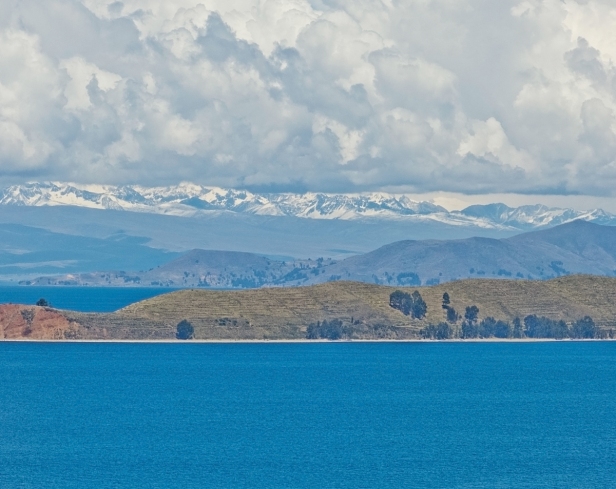
Isla del Sol (Island of the Sun) is about an hour by boat from Copacabana, Bolivia. You can hike from one end of the island to the other in about 4 hours. There are reputedly 210 steps to climb to begin the hike if you start at the south end. I counted but lost track at 240something. At the bottom of the steps are Manco Capac, and Mama Ocllo who according to legend were born on Isla del Sol and are the ‘Adam and Eve’ of the Incas.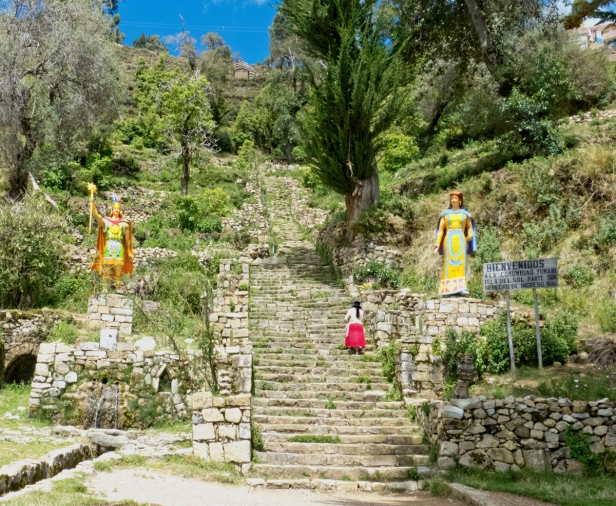
At the top of the steps, beyond this entrance gate, is the village of Yumani.
The approximately 5000 people on this island live a simple rural subsistence life. There are no motor vehicles or paved roads, and the hilly terrain is harsh and rocky. Here we saw simple village and rural life dating back hundreds, if not thousands, of years. They make a living through farming and fishing, and some tourism. Everything is moved up and down the steep hills by people or by donkey,


alpaca are raised for their wool,
and crops such as beans and potatoes are grown on hard-won ancient terraces.

The stairs, the gate, and the ruins at the north end of the island, are frequently referred to as Incan though were probably built by the Aymara who lived here for hundreds of years before the rise and dominance of the Inca peoples. The Incas believed their Sun God, the god of all gods, was born here.
It was a brilliant sunny day, and we were thrilled to have reasonably warm weather and to be out of Copacabana. We were at considerable altitude so I can’t say we climbed the stairs with abandon, but we were determined to get to the top. Besides we had all day and it didn’t matter how slow we were. Along the way we met this sweet child. I asked to photograph her to which she replied ‘propina’, meaning tip. I happily agreed. Clearly she had already learned from the adults around her to ask tourists for money for photos. I think we settled on two Bolivianos. It may have been the first money she had ever earned by herself. She was both shy and open at the same time, and quick to smile once the ice was broken. You can see the soft innocence in her eyes.
We walked for about two hours soaking up the sun and spectacular views,
had tea at a restaurant high up on the top of the island, then headed back down the way we’d come. On the way back down we got a peek inside one of the family compounds,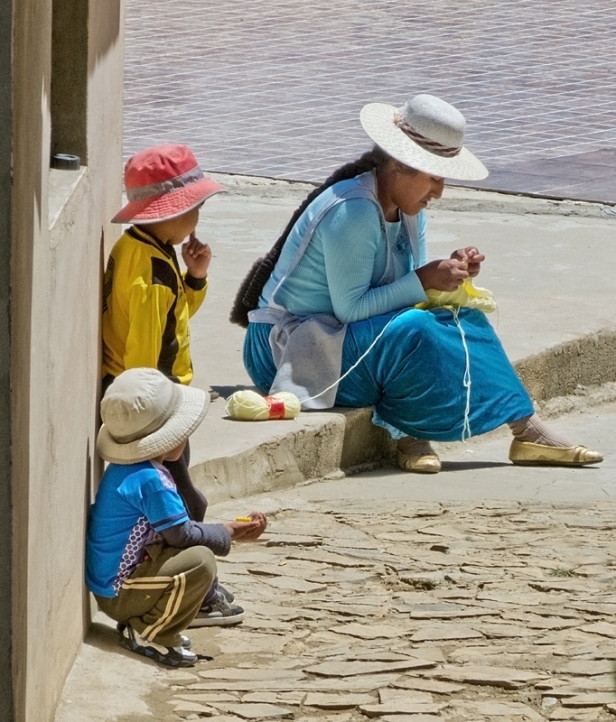
and down at the wharf, waiting for the ferry, we carefully avoided this angry llama who clearly was going to spit at anyone who annoyed it further.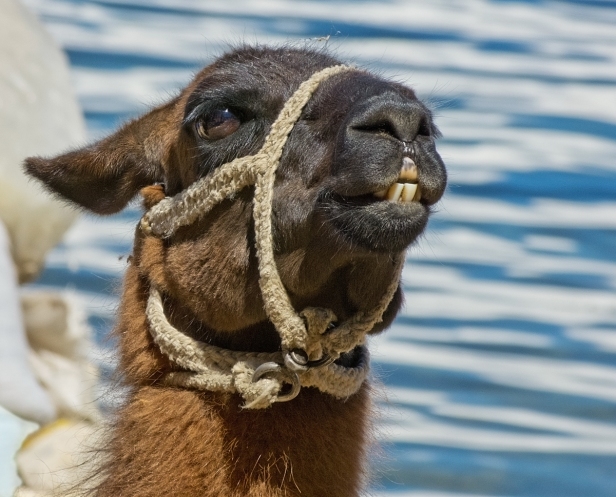
From Copacabana, Bolivia we travelled by bus to Puno in Peru, also on the shore of Lake Titicaca. We arrived at lunchtime on a sunny day, checked into our hotel, and almost immediately went back out to visit the reed islands of the Uros people.
As best as I can gather, in the Aymara language titi means puma, and kala or kaka means rock. There’s apparently a rock that is vaguely puma-shaped at the north end of Isla del Sol. The man who gave us a potted history of the Uros islands implied kaka or caca means hare and showed an aerial view of the lake, which does kinda sorta look like a puma eating a hare if you have a good imagination. My immediate question was a loud “how did they know that?” How did they know the lake was that shape? That could only be known by seeing it from above. My question was ignored but it sure got me thinking about the Nazca Lines, and the things ancient people seemed only to be able to know about by being very high up above it, and about Chariots of the Gods. Everything I read declared titi means puma in the Aymaran language. There are various interpretations of the kaka/caca/kala part. It means rock or hare or maybe something completely different. Ancient legends shrouded in mystery. And over hundreds of years everyone makes up something different. A bit like that whispered telephone game.
I have such mixed feelings about the Uros Islands. I’d been there many years ago for a brief visit. I knew nothing about them and was too full of the hubris of youth to ask or even really care. I was fascinated by the people and their way of life, and by walking on the dry but spongey islands made of reeds, and seeing chickens wandering about, and houses and boats made of reeds. Fascinating to look at it all, but I didn’t learn a thing about the people or their way of life or why they lived on islands made of reeds floating in the lake. I just looked. And then we moved on to the next thing.
Thirty-five years later a visit is a very organized touristy affair. It was Don’s first time there and he enjoyed it. We were taken to two islands. On the first we got a glimpse into the way the people live (there were reed houses we could look into), and a short talk about the history of the islands. We were then very much encouraged to buy some of their brightly coloured craftwork.
On the way to the islands
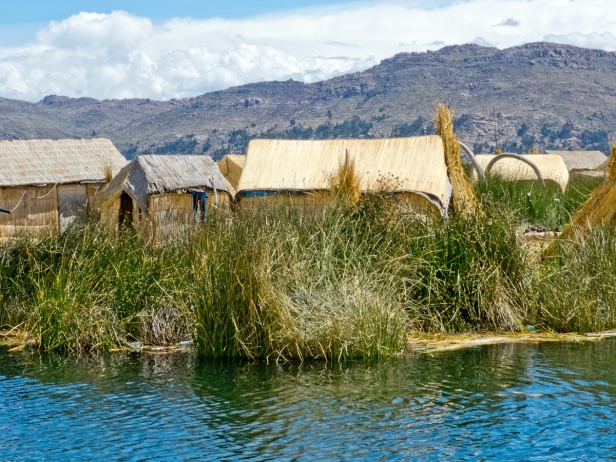
Inside the reed houses

Flat stones make a fire surface with a ceramic ‘stove’ over it for cooking.
We were taken by a double-hulled (fake) reed boat to the second island. Don got a chance to “row” not realizing that the boat was being pushed along from behind by a small dinghy with an outboard motor. He had fun anyway. The boat was fake in that it was not built of reeds, just covered in them. It was getting a bit worn and you could see the blue tarp underneath.
This island was essentially a ‘restaurant’ where we could buy a drink and a meal. There was a kitchen building, a service counter, and several open-sided buildings for tables and chairs. Since we hadn’t had lunch this was welcome, but not anything unique to these islands. However, being snoopy, and wanting a more authentic experience, even if only briefly, I wandered around behind the scenes and found:
These two people making what I’m guessing will be new roofing,
this little scene – laundry drying in the sun, a couple of kids playing, and a small fish farm,
this older woman, completely at home in possibly the only environment she has ever known,
and this young boy heading off in a boat, as natural to him as walking.
I was a little disturbed to be told by our guide that sixty percent of the islanders are now Mormon, and to see that the two young men in charge of the restaurant island wore name tags – Elder Ramirez, and Elder Martínez. However other information gives completely different numbers for the religious demographics of the islanders. According to one source the Uros almost died out until the Mormons came. Another source says they almost died out until the Catholic missionaries came. Yet another source said maybe 5% follow the ancient worship of Pachamama, the earth mother, 70% are Catholic (probably meaning they still have ties as well to the worship of Pachamama), 15% are Adventists, 5% Protestants, and 5% Mormons. Hmmmmm. That’s a whole different picture. There is a floating Mormon missionary school and a traditional school up to grade six. According to Rough Guides the inhabitants of the islands are ‘much abused’. However these three posts that tell the story of a French-Norwegian family who spent two days staying with a Uros family paint a much happier picture. I recommend reading it if you want to know more of daily life on the islands.
The Uros people are pre–Incan people who took to living on the lake centuries ago as a defensive measure. There are about sixty islands in all. Each island houses anywhere from three to ten families, depending on the size of the island. The islands are made of totora reeds, that grow naturally in the lake, and take about a year to construct from huge dense masses of roots all bound together with layers of reeds criss-crossed over the top. New layers need to be added frequently to replace those rotting underneath. Here one man is harvesting reads for this purpose, and in the following picture a couple of men bring in a full boatload. I think the reeds are also dried and used as fuel for cooking fires.

The people fish, hunt birds, and even graze cattle on the islands. Ibis are domesticated for meat and eggs.
An aid project some years ago brought them the very great boon of solar panels for electric light. Some entire islands had previously burned due to the use of candles. You can see the solar panels in this photo of a young woman in traditional skirt and jacket.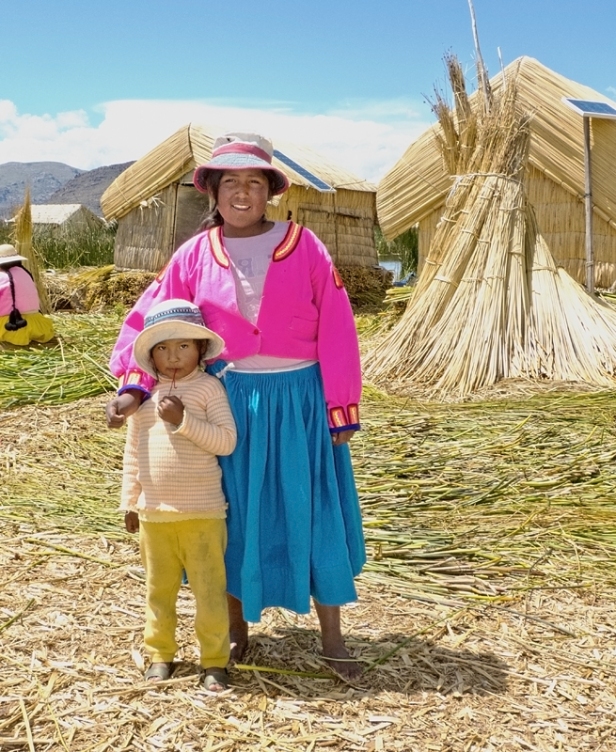
As I said I have mixed feelings about it all. About two thousand of the Uros have somewhat managed to retain their traditional lifestyle, and I’m happy if our tourist dollars help improve their lives even if it means we tourists are given a controlled and constructed ‘Uros experience’ designed to get us to spend our dollars there. I’m not sure I support the Mormon influence and wonder how much of the income from tourism goes to the Uros people. I can say they have schools, a medical clinic, and solar lighting on their islands, and from the description in the article cited above it’s certainly not all bad. I’m still completely astonished by the utterly dazzling uniqueness of the lives of these people. And by the sheer incredible creativity of forming whole islands, boats, houses, watch towers and other constructions from the reeds growing in a lake. Once again I’m floored by the creativity of the world and the infinite number of different ways in which people do life.
*************
We had two more days in Puno. The weather was not wonderful and we were not drawn to go exploring much, but two evenings in a row we heard drumming in the streets and went to find out what it was. We found this:
and this
and this.
It was dancers practicing for Fiesta Candelaria. In a heartbeat we changed plans and made bookings to return for the festival in February. Much more on this in later posts. It’s one of the biggest festivals in South America.
Next post: What a contrast from the Uros islands – a luxury train ride to Cusco, the capital of the Inca Empire, and visiting villages and Inca ruins in The Sacred Valley, Peru.
All words and images by Alison Louise Armstrong unless otherwise noted.
© Alison Louise Armstrong and Adventures in Wonderland – a pilgrimage of the heart, 2010-2015.

Magnificent! Bravo~
LikeLike
Thanks Cindy. Hope to be able to catch with your latest posts soon. Worst thing about the Amazon? Net speed so glacial most sites wouldn’t open. Oh and mosquito bites!
LikeLike
Shortly before, the town had been featured on TV in Japan .
I could not believe that there is a town on the lake.
The picture is very beautiful, I wanted to go to the town.
LikeLike
Thank you choco. It is a very interesting place. Maybe one day you will get to go there. I would really recommend staying with a family on one of the islands.
LikeLike
Amazing pictures and story ! It makes me want to go there!
LikeLike
Thanks so much. Yes it’s an amazing place. No where like it in the world. Go there, it’s worth it, but if you do go stay with a family for a couple of days – you’ll have a much richer experience.
LikeLike
You made me go to Google Earth and look at the Lake from above. Yes, I can see the puma about to eat the hare. Or perhaps just having a chat with it? 🙂
LikeLike
Probably just having a chat 🙂
I do wonder how these myths start. I’ve read that it’s really a stretch to see the puma in the so-called puma rock on Isla del Sol too. Either way it certainly seems to be about pumas!
Speaking of which (kinda) we saw fresh jaguar prints in the jungle in the Amazon! Too cool!
LikeLike
Gorgeous photos as always, but I partlcularly love the one with the reeds/flowers in focus on the foreground and the boy in the boat in the background. Terrific composition.
LikeLike
Thanks Fiona. I’ve always loved that photo. It came out even better than I’d hoped. I’m also pleased with the one of the little girl on Isla del Sol. She was so sweet. And once again it was so helpful to have a bit of the local language. My Spanglish is excellent 🙂
LikeLike
So much fun looking at your pictures and hearing your thoughts upon visiting Lake Titicaca and Puno. It seems like forever since we’ve been there, and not just last summer, so I really appreciate the “booster” shots!
LikeLike
Oh you’re welcome! Happy to provide booster shots 🙂
Did you stay on the islands? What was your experience like – must go poking back through your archives 🙂
From what I’ve read I think it would have been a much richer experience to do a home stay for a couple of days. Still it’s amazing to even see such a place. It’s amazing that it exists!
LikeLike
Hi Alison,
We had an overnight home stay on one of the Peruvian Islands, and had a traditional dinner cooked over the hearthfire. Our visit coincided with a festival that involved music, parades, and bonfires. We made another stop the next day at an island famous for its knitting men. I was quite ill with altitude sickness–short of breath and feverish, so I missed out on some of the fun. But it was a really fascinating peek into another culture and way of life.
LikeLike
Oh that sounds amazing. I love experiencing the local festivals. Such a richness of creativity and joy!
LikeLike
I just went and read your post about it. I remember now that I read it at the time you posted it. I really liked what you said about the fine line between retaining cultural traditions and adapting to the changing world around. It really stuck with me, and certainly influenced my perception. It was touristy, but also showed us something of the tradition and history of the people.
LikeLike
Am heading there in a few months time and I can’t wait !
LikeLike
Hope you have a fabulous time! It really is amazing, and very unique.
LikeLike
Great pics! 🙂
LikeLike
Thanks Kev.
LikeLike
I found myself full of longing looking at these pictures, imagining other lives, traveling among such terrain with you. Thank you for such an experience and seed planting within me a wanderlust 🙂
LikeLike
Thank you Marga. I’m glad you feel like you are travelling with us. It is an astonishing journey. South America in many ways has been harder travelling than SE Asia, but such an extraordinary and rich experience. Let that seed grow. The rewards of travelling are beyond measure.
xox
LikeLike
I’ve not been to this part of Peru but I’ve seen religious missionaries in Guatemala and South East Asia. I am very saddened that these people try to get the local people to give up their beliefs and crafts. In Guatemala the missionaries discourage local dress. I’ve always felt we should celebrate the differences and learn how other folks live their lives–not try to make them into something else.
LikeLike
We’ve just come from the Amazon and visited a village where the Evangelical missionaries have converted about half the village, and, for example, have the women wearing long skirts (so utterly inappropriate for that climate). They have managed to completely divide what was once a cohesive and mutually supportive community. So arrogant of them to think they should tell others how to live. It has not improved their lives at all. There are Catholic missionaries there as well and although of course they preach their religion, they are very much concerned with the welfare of the people and bring supplies, set up schools and clinics, and do what they can to improve living conditions.
I so very much agree that we should not try to make others into something else. The differences bring such a richness to the world.
LikeLike
Yet another splendid post, Alison 🙂
Your posts are special, it gives an overview of the people, culture, landscape other flora and fauna of the places you explore.
Thanks a lot for sharing.
Have a great time 🙂
LikeLike
Thank you so much Sreejith. Glad you enjoy my efforts. It’s such an amazing world we live in!
LikeLike
An adventure of a lifetime. Wonderful place with rich culture and very warm, generous people. Th landscape, just beautiful and breathtaking. Thanks for sharing these. Have a great week ahead.
LikeLike
Thanks so much. Yes it really is the adventure of a lifetime. We feel very fortunate.
LikeLike
Random thoughts: Bet the shot of the Llama getting ready to spit was taken with a telephoto. 🙂 Love the shot of the old woman– such character. Flying saucers, hmm. I want to believe. And the festival; I swear the locals break into dance when you guys arrive. –Curt
LikeLike
Um, yes, telephoto. One look at that face and I moved right back 🙂
I also was pleased with the shot of the old woman – she looks so completely at home. Flying saucers – I believe 🙂
I also am convinced locals break into dance upon our arrival. We have voodoo dolls we stick with magic dancing pins 🙂 to go along with the flying saucers 🙂
LikeLike
Glad to know that you two come well prepared. 🙂 –Curt
LikeLike
Don looks very healthy in that photo! Lovely countryside, people, and animals (that alpaca has a lot of hair!) It really inspires an appreciation in me to see the man carrying that load up the steep road. Gives pause for what goes into all we have and the toil that brings things to market, or just to one home. Such a wonderful post. xoxo
LikeLike
Thanks Paulette. He is healthy! though we have our ups and downs. The Amazon was a challenge because of heat and humidity and we hiked long distances on several days and discovered how out of condition we’d become from all that time at altitude not doing much. And I’m covered in mosquito bites (moan) – but really all is well.
I’ll have pics in a future post of alpacas and llamas with even more hair! Cute though, eh?
Endless toil to make a living, to make a life. Most people live this way I think. The lucky ones are the ones that do have enough even if it is a subsistence life. The people of Lake Titicaca seemed generally healthy, even though they work so hard. We saw the same with the hill tribe people in northern Vietnam.
We have not seen anything like desperation, or famine conditions here. Compared to Africa South America seems fine.
LikeLike
🙂
LikeLike
What an interesting concept – a whole island woven out of reeds. I share your hope that the Uros people have retained something of their centuries-old spiritual beliefs.
LikeLike
Isn’t it amazing! I’m continually astonished by how creative people are.
I suspect we were taken on our little tour to Mormon islands, hence the statistics we were given. There’s a lot on information on the net that is contradictory.
Throughout South America we’ve seen Catholic ceremonies where the indigenous population have retained their ancient spiritual practices and incorporated them into the Catholic celebrations (e.g. Guelaguetza in Mexico, the first-sunday-of-the-month ceremony in Ollyantaytambo, and Fiesta Candelaria in Puno (both in Peru), and Christmas Day in Copacabana, Bolivia. These are Catholic ceremonies involving worship of saints, and ceremonies in churches and cathedrals, but make no mistake they are really as much about the worship of Pachamama, and the other 3 main deities (I’ve forgotten though I was told – Earth, Sun, Fire maybe and a forth natural element) as they are about any Christian god.
It is the missionaries that completely outlaw the ancient practices that I have trouble with. Such heart-breaking hubris.
LikeLike
Reading of these experiences and seeing your pictures is so delightful. I love most of all knowing there are people living in these other ways on our planet, living on islands made of natural fibers, living in tiny shelters more suitable most days, perhaps, for housing the authentic human spirit, than so many of the places we spend our time in the “developed” world. I know that may be a naive and romantic view… 🙂 You can almost taste the richness of a simple life in these images, and I don’t mean simple as in simplistic, but richly simple. I’m glad Pachamama is holding his/her own… 🙂 Love is love. It doesn’t need a name to be what it is. It doesn’t need a particular type of house. And it sure does abide in some beautiful places!
Michael
LikeLike
Thank you Michael. I don’t think it’s naive, or romantic. I think living close to the earth, to nature, engenders a richness that has nothing to do with material wealth. It engenders connectedness with the earth, with spirit, with a deeper truth, with the utter simplicity of live. Life always knows how to live itself. It is so capable it knows how to live itself even when the “me” gets in the way.
Pachamama thrives for the country people I think. These people live so close to the land they cannot help but know it.
LikeLike
Another fab post, Aloson. Love the photos of the dancers in their purple costumes, the little girl, the older woman and the llama. in fact they are all great, and Don looks very handsome. I found your discussion on religion fascinating. Why am I not surprised? So much cheaper to control people by getting into their heads than firing guns. Thanks for sharing.
LikeLike
Thanks Helga. There will be many many more photos of dancers in fab costumes when I finally get to do some posts about Fiesta Candelaria (I’ll try to restrain myself!) Don says thanks 🙂
Oh the whole religion thing – I know things are rarely black and white, but this is an issue that can make me both mad and sad. There’s a lot of hubris in it that I find quite breathtaking.
LikeLike
Sorry for the typo Alison!
LikeLike
We all make them. I especially love auto correct – every time it makes me wonder what keys exactly did I hit that it came up with such a weird solution.
LikeLike
Alison, how strange it must have been to see the difference between the first time you visited the Uros islands and how it is now. I too would have very mixed feelings, especially about being taken on a very controlled tour, but then again if I lived there, would I appreciate strangers looking into my house?
Your mention about the hubris of youth was very thought-provoking… if I looked back on my recent travels 30 or maybe 40 years from now, would I be saying the same thing? Sadly it’s all too easy for us to go somewhere and just look, without attempting to dig beneath the surface. And so many travel blogs out there address the how and where but not the why.
As usual you take magnificent photos, they have me dreaming of going there someday. I had no idea about the origin of the name ‘Titicaca’ so it was great to learn about some of the local legends. As for the bowler hats, they don’t seem very popular with younger women, except maybe for dances like the ones you saw in Puno!
LikeLike
I do understand the people would not want tourists wandering through their homes but there is a happy medium, I think, where more is offered than a thinly veiled set- up to make money. It felt greedy. I don’t think the Uros people are greedy people so I question the set-up . . . . . . There is also the alternate option of a home stay and I’m mildly disappointed we didn’t do that.
I have no doubt at all that you don’t have anything like the hubris of youth that I had. I was pretty ‘me’ focused, and scattered when I was young. I didn’t really look, or *see* things. The most striking example I can remember is the difference in how I saw the Eiffel when I was 20something and how I saw it when I was 50something. I was astonished. You write with such depth and sensitivity that I’m sure you’ll be able to look back on your work with pride.
Thank you for your kind words. I hope you get to Peru, and Bolivia. Both are definitely worth visiting. I know in La Paz there’s a great ‘rise of the Cholitas’ taking place at the moment where they are beginning to hold positions of power and respect in the community. The Chollas, or Chollitas, are the peasants that migrated to La Paz looking for work in the early 20th Century. They are the ones who adopted the bowler hat as part of their ‘traditional’ dress. So I don’t think it’s dying out there. On the contrary. However in the towns of Bolivia and Peru it is dying out and in another generation or two and it could be gone.
LikeLike
Peru is one place I havent been to, but because of your Blog post it is at the top of my list. Great post!
LikeLike
Thank you so much. There will be many more posts on Peru to come. We spent 2 months there and found it to be a fascinating country. Really worth visiting.
LikeLike
Alison, the people and and their lifestyle of the Uros Islands is truly amazing – and you’ve captured it with such skill and compassion. Beautifully done! ~ Terri
LikeLike
Thank you so much Terri. As I said to James in the comment above, I’m mildly disappointed we didn’t do a home stay, but even just to see such an extraordinary lifestyle was an amazing experience. And it was probably better that we didn’t do a home stay. The day we arrived in Puno was bright and sunny. The next couple of days cold and rainy.
LikeLike
Such an interesting article. Always amazing, as you say, how people of this world live.
Joanne
LikeLike
Thanks Joanne. It’s such an interesting place. If someone had told me that there was a group of people living on islands made of reeds in the middle of a lake, and that all their buildings and boats were made of reeds, I’m not sure I would have believed it. It seems so impossible, and yet we humans continually prove to be endlessly resourceful and inventive.
LikeLike